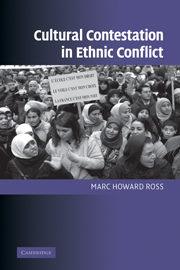Book contents
- Frontmatter
- Contents
- List of figures
- Preface
- 1 Introduction: easy questions and hard answers, what are they fighting about?
- 2 The political psychology of competing narratives
- 3 Narratives and performance: ritual enactment and psychocultural dramas in ethnic conflict
- 4 Loyalist parades in Northern Ireland as recurring psychocultural dramas
- 5 Where is Barcelona? Imagining the nation without a state
- 6 Digging up the past to contest the present: politics and archeology in Jerusalem's Old City
- 7 Dressed to express: Islamic headscarves in French schools
- 8 The politics of memory and memorialization in post-apartheid South Africa
- 9 Enlarging South Africa's symbolic landscape
- 10 Flags, heroes, and statues: inclusive versus exclusive identity markers in the American South
- 11 Culture's central role in ethnic conflict
- References
- Index
- Cambridge Cultural Social Studies
6 - Digging up the past to contest the present: politics and archeology in Jerusalem's Old City
Published online by Cambridge University Press: 22 September 2009
- Frontmatter
- Contents
- List of figures
- Preface
- 1 Introduction: easy questions and hard answers, what are they fighting about?
- 2 The political psychology of competing narratives
- 3 Narratives and performance: ritual enactment and psychocultural dramas in ethnic conflict
- 4 Loyalist parades in Northern Ireland as recurring psychocultural dramas
- 5 Where is Barcelona? Imagining the nation without a state
- 6 Digging up the past to contest the present: politics and archeology in Jerusalem's Old City
- 7 Dressed to express: Islamic headscarves in French schools
- 8 The politics of memory and memorialization in post-apartheid South Africa
- 9 Enlarging South Africa's symbolic landscape
- 10 Flags, heroes, and statues: inclusive versus exclusive identity markers in the American South
- 11 Culture's central role in ethnic conflict
- References
- Index
- Cambridge Cultural Social Studies
Summary
Introduction
Metaphorically the holy sites in Jerusalem's old city are ground zero of the Israeli–Palestinian conflict. The mutually exclusive claims Jews and Muslims make concerning sovereignty, rights, and identity played out in excruciating detail around contested above and below ground sacred space parallel the emotionally intense differences about political existence found in the larger conflict of which Jerusalem is just one part. While contestation in Jerusalem takes many forms and has many different foci, these always come back to questions of power, control, vulnerability, and purity. The mutually exclusive claims each side regularly makes set off a spiral reaction from the other that leave little room for the development of inclusive symbols and rituals that could define a community that offers mutual recognition and shared spaces, and where one group's existence is not necessarily a threat to another. The competing narratives and psychocultural dramas over the Old City of Jerusalem's holy sites occur because, “Sacred centers are not just reflections or traces of political power: they are often instruments and sources of political power” and intimately tied to the larger conflict (Friedland and Hecht 1998: 147).
For the past 100 years or so, the most intense Muslim–Jewish conflict in Jerusalem has been over the area on, under, and next to what Jews call the Temple Mount (Har Habayit) and Muslims the Noble Sanctuary (Haram al-Sharif) (Figure 6.1).
- Type
- Chapter
- Information
- Cultural Contestation in Ethnic Conflict , pp. 154 - 190Publisher: Cambridge University PressPrint publication year: 2007
- 1
- Cited by



